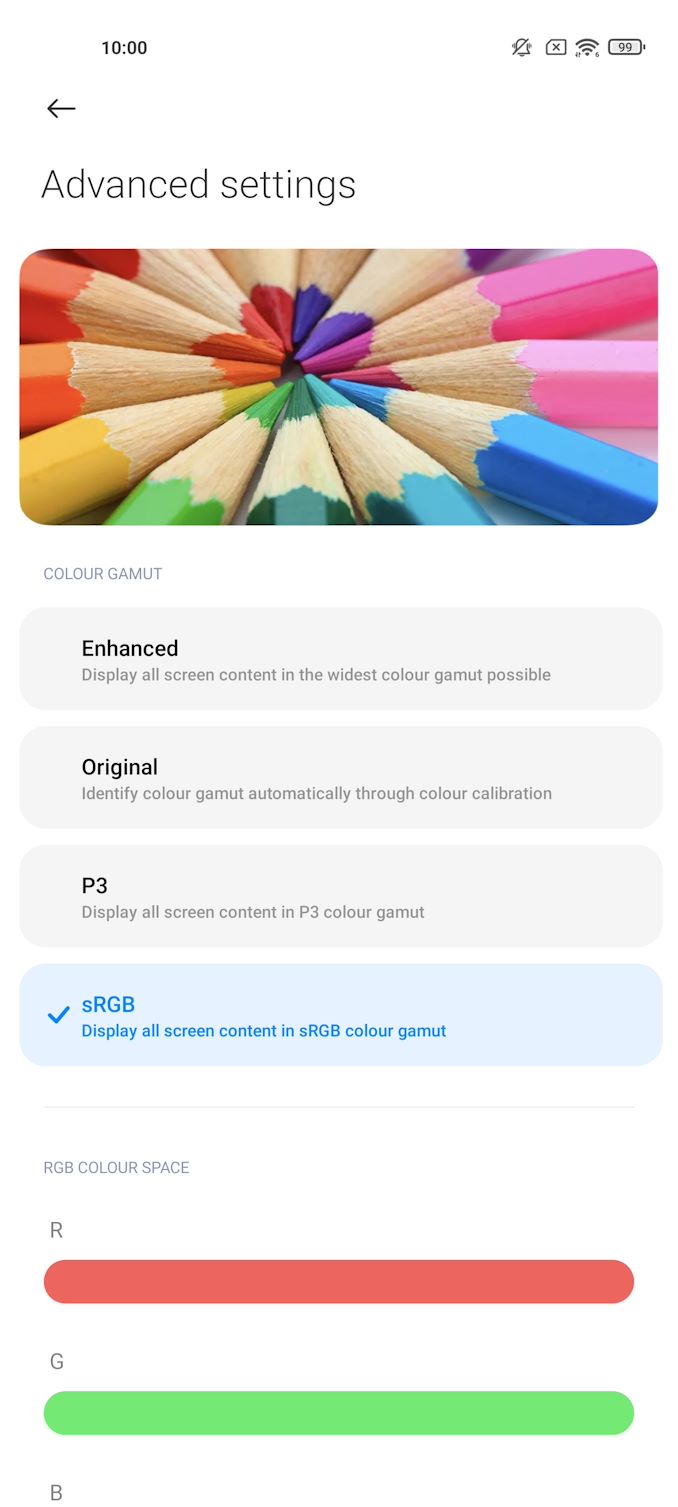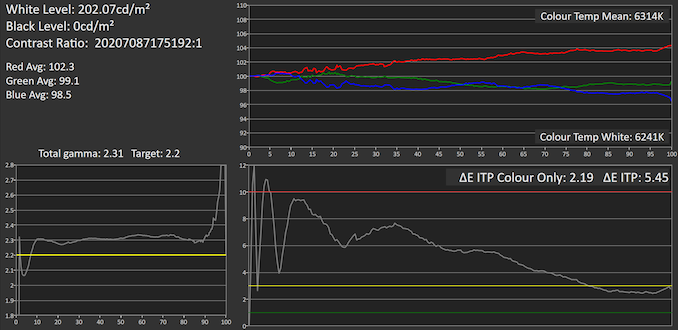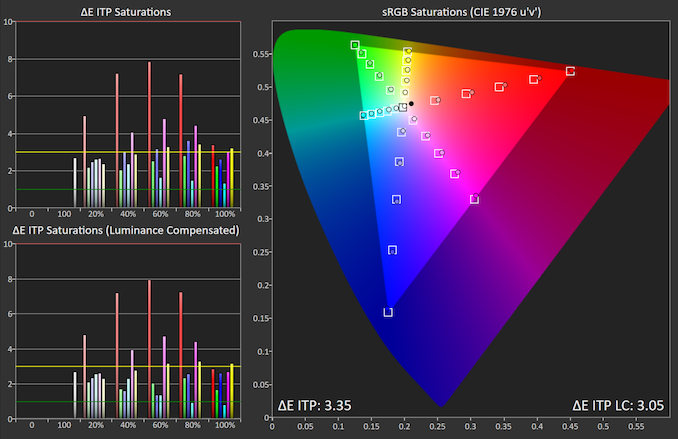The Xiaomi Mi 11 Review: A Gorgeous Screen and Design
by Andrei Frumusanu on March 10, 2021 8:00 AM EST- Posted in
- Mobile
- Smartphones
- Xiaomi
- Snapdragon 888
- Mi 11
Display Measurement
The display of the Mi 11 is a highlight of the device. A 1440p, 120Hz AMOLED panel is a major step-up in Xiaomi’s device line-up, and is a definitive improvement over past year implementations in the mainline Mi series.
The panel is of a similar generation we’ve seen in last year’s Galaxy S20 series as well as on the OnePlus 8 Pro – more similar to the latter unit as Xiaomi allows 1440p at 120Hz simultaneously. What’s lacking for the device, is any kind of variable refresh rate mechanism, no software based coarse VRR as on the base S21 series, neither a more advanced hardware one as on the S21 Ultra.
Edit March 12th: The Mi 11 does have a coarse software-based refresh rate switching mechanism, however it does not function below 110 nits screen brightness (around 70% on the brightness slider).
In terms of screen calibration and controls, Xiaomi gets top marks here as the company offers various different default operating modes which offer fine-tuning of the colour temperature, as well as offering an advanced fully custom mode where you can fully control the screen calibration from hue, saturations and even gamma controls. Generally speaking, you are able to set up the display of the Mi 11 however you like it the most, and I applaud such levels of customisation.
What we’re testing today is the “Original colour” mode at its default settings, which is supposed to be a calibrated target to sRGB and P3 standards.
We move on to the display calibration and fundamental display measurements of the Xiaomi Mi 11 screen. As always, we thank X-Rite and SpecraCal, as our measurements are performed with an X-Rite i1Pro 2 spectrophotometer, with the exception of black levels which are measured with an i1Display Pro colorimeter. Data is collected and examined using Portrait Display's CalMAN software.

In terms of brightness, the Mi 11 is a top performer. At 850 nits peak full screen white brightness when in auto-brightness and under brightly lit ambient light, the screen only falls behind the newer S21 Ultra which has a superior emitter technology. Under manual brightness, the phone lands in at 487 nits, which is in line with what we’ve seen in the Mi 10 Pro last year.
In the greyscale performance, the Mi 11 is quite a bit off the mark in two aspects. First of all, the reds are quite dominant as average colour temperature lands in at 6314K, and whites land in also reddish at 6241K, below an ideal 6505K target for pure daylight white. This gives the Mi 11 a colour dETIP of 2.19.
The more offending discrepancy however is in the gamma, where the Mi 11 apparently targets a 2.3 figure, measuring in at 2.31 average. This is higher than a typical 2.2 calibration, and it means that tones will appear slightly darker than they should be, possibly giving content a little more contrast than what they’re meant to be displayed at. This regresses the overall dEITP to 5.45.
In the saturations, we’re seeing generally good performance in most colours except for the reds and the magentas, which are oversaturated and too dominant, again similar to the too warm colour temperature in the greyscale values.
Finally, in the GretagMacbeth patches of commonly found tones such as skin tones, the Mi 11 does averagely. It’s not a total disaster, but we’re seeing the too dark luminance due to the higher gamma, as well as oversaturation in the reds. Both aspects end up with the Mi 11 getting an dEITP of only 5.04.
Generally, the screen of the Mi 11 is still excellent when it comes to its fundamentals – fantastic brightness, contrast, resolution and of course that 120Hz refresh rate. The colour calibration isn’t the best, but it’s still adequate enough, and at least Xiaomi gives you extensive controls to adjust the screen to your liking. At least at this price point, the Mi 11 is able to compete extremely well with just the fundamental characteristics of the display, even if it’s not the most advanced or accurate panel out there.


















85 Comments
View All Comments
Pedro10alves - Thursday, March 11, 2021 - link
Nice to see you in my home country Luxembourg. Wonderful picturesSpellingBee889 - Thursday, March 11, 2021 - link
Our world is youMoePtyan - Friday, March 26, 2021 - link
Thank you Andrei Frumusanu for the review.I am a reader from China and of course a digital fan. I would like to add some explanations to some of the article based on what I have learned.
The SoC power control strategy is different for real games and benchmark tests. It's because Xiaomi added the " God hidden mode" as a means of global background control of running power in earlier versions of MIUI. The principle of its implementation is to define the SoC temperature threshold and SoC frequency for different Apps, and even control the hardware refresh rate of the screen when different Apps are opened.
The configuration file of "God Hidden Mode" is sent from the cloud, and the update frequency is 7-15 days as long as the phone is connected to the Internet. You can call *#*#76937#*#* to check the control panel of this profile.The difference between "China server" and "International server" is the configuration for different regions of Apps. I have a positive opinion about the " God Hidden Mode". You can call *#*#76937#*#* to check the control panel of this profile.The difference between "China server" and "International server" is the configuration for different regions of Apps.
I have a positive opinion about the " God hidden mode " approach, and I am a Genshin Impact player.Due to the presence of the "hidden mode", the X1 big core often runs below 1Ghz while gaming, which results in better sustained performance and temperature threshold performance. Of course, this feature is definitely not meant for benchmarking fraud, but for better longevity and sustained performance.
MoePtyan - Friday, March 26, 2021 - link
Incidentally, this profile can be deleted. In the application management of the settings panel, find "Power & Performance" (I'm not sure if this is the name of the international version of MIUI) and clear the application data, and the temperature and frequency profiles of all Apps will be deleted. At this point the phone is not suitable for daily use, the battery life is very bad, often hot, but the performance has been unlocked. Many senior Chinese players will use this method, the phone plus the cooling back clip together.Samrich - Tuesday, June 1, 2021 - link
1